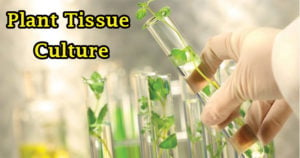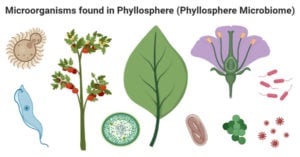Agricultural Microbiology
Agricultural microbiology is a branch of science that studies different microorganisms that are associated with plants, soil fertility, and even animal diseases.
- The microorganisms associated with plants include organisms of different groups like bacteria, fungi, actinomycetes, and protozoa.
- Agricultural microbiology has been extensively studied for the decade as it helps to understand the importance of relevant microbial strains to agricultural applications to minimize agricultural loss, increase soil fertility, and harvest.
- There is a symbiotic relationship between plants and the associated microorganisms where both benefit from each other.
- Besides, different topics within agricultural microbiology help in the diagnosis and prevention of plant diseases that might result from plant pathogens.
- Agricultural microbiology helps in the understanding of the specific plant requirements that include soil texture, soil nutrients, water content, and associated microorganisms.
- Based on the studies made in agricultural microbiology, different microorganisms can be used for different purposes, all ultimately leading to minimizing loss of plant and plant products and increasing fertility and harvest.
- These studies also help reduce production costs and explore areas for the production of plants in laboratories via techniques like plant tissue culture.
- The dominant group of microorganisms found in the soil and plants is bacteria. These bacteria are present in a symbiotic relationship with the plants to help in processes like nitrogen fixation and mineral supply.
- Bacteria are followed by actinomycetes, as the second most dominant group. Actinomycetes are also studied in agricultural microbiology as they produce different groups of antibiotics and also help in increasing the fertility of the soil.
- Well-aerated, cultivated, or acidic soils are mostly colonized by fungi which in association with plants help in increasing the harvest by providing necessary minerals and vitamins.
- Agricultural microbiology allows for the exploration of new and advanced techniques that can be used in agricultural practices to make the practices safer and reliable.
Soil- Definition, Composition, Properties, Types And Uses
What is Soil? Soil is a biologically active porous medium that is present on the uppermost layer on the uppermost layer of the Earth’s crust formed by weathering processes under … Read more
Plant Tissue Culture
Plant Tissue culture is the in vitro aseptic culture of cells, tissues, organs, or whole plant under controlled nutritional and environmental conditions often to produce the clones of plants. It … Read more
Microbial Degradation Of Chitin (Enzymes, Steps, Mechanisms)
What is chitin? Chitin is a complex homopolysaccharide consisting of units of amino sugar glucosamine that accounts for the second most abundant polysaccharide of nature after cellulose. It is widely … Read more
Rhizospheric Microorganisms And Effects, PGPR And Mycorrhiza
What is Rhizosphere? The rhizosphere is the narrow region of soil around the plant root that is influenced by several factors like the root exudates and the associated soil microorganisms. … Read more
Agrobacterium-Mediated Gene Transfer (Transformation) In Plants
What is Agrobacterium? Agrobacterium is a phytopathogen that infects plants through wound sites, causing crown gall disease, and is one of the most popular plant transformation tools used in agriculture … Read more
Organic Waste Recycling (Methods, Steps, Significance, Barriers)
What are organic wastes? Organic wastes are materials originating from living sources like plants, animals, and microorganisms that are biodegradable and can be broken down into simpler organic molecules. Organic … Read more
Microbial Degradation Of Pectin (Enzymes, Steps, Mechanisms)
What is pectin? Pectin is a complex heteropolysaccharide composed of linear chains of α-D-galacturonic acid or other similar sugar derivatives, commonly found in plant cell walls as cementing material. Pectin … Read more
Microbial Degradation Of Lignin (Enzymes, Steps, Mechanisms)
What is lignin? Lignin is a group of complex aromatic polymers resulting from the oxidative combination of 4-hydroxyphenylpropanoids. Lignin is a phenolic polymer that is amorphous, irregular three-dimensional, and high … Read more
Microbial Degradation Of Hemicellulose (Enzymes, Steps, Mechanisms)
What is hemicellulose? Hemicellulose is a group of complex polysaccharides that are found in the fibers of plants along with other polysaccharides like cellulose and pectin. Hemicellulose consists of a … Read more
Microbial Degradation Of Cellulose (Enzymes, Steps, Mechanisms)
What is cellulose? Cellulose is an organic polysaccharide composed of a linear chain of hundreds of β-linked D-glucose units. Figure: Cellulose, a linear polymer of D-glucose units (two are shown) … Read more
Agricultural Microbiology
Agricultural microbiology is a branch of science that studies different microorganisms that are associated with plants, soil fertility, and even animal diseases.
- The microorganisms associated with plants include organisms of different groups like bacteria, fungi, actinomycetes, and protozoa.
- Agricultural microbiology has been extensively studied for the decade as it helps to understand the importance of relevant microbial strains to agricultural applications to minimize agricultural loss, increase soil fertility, and harvest.
- There is a symbiotic relationship between plants and the associated microorganisms where both benefit from each other.
- Besides, different topics within agricultural microbiology help in the diagnosis and prevention of plant diseases that might result from plant pathogens.
- Agricultural microbiology helps in the understanding of the specific plant requirements that include soil texture, soil nutrients, water content, and associated microorganisms.
- Based on the studies made in agricultural microbiology, different microorganisms can be used for different purposes, all ultimately leading to minimizing loss of plant and plant products and increasing fertility and harvest.
- These studies also help reduce production costs and explore areas for the production of plants in laboratories via techniques like plant tissue culture.
- The dominant group of microorganisms found in the soil and plants is bacteria. These bacteria are present in a symbiotic relationship with the plants to help in processes like nitrogen fixation and mineral supply.
- Bacteria are followed by actinomycetes, as the second most dominant group. Actinomycetes are also studied in agricultural microbiology as they produce different groups of antibiotics and also help in increasing the fertility of the soil.
- Well-aerated, cultivated, or acidic soils are mostly colonized by fungi which in association with plants help in increasing the harvest by providing necessary minerals and vitamins.
- Agricultural microbiology allows for the exploration of new and advanced techniques that can be used in agricultural practices to make the practices safer and reliable.
Phyllosphere Microorganisms- Examples, Factors, Effects
What is Phyllosphere? Phyllosphere is the aerial part or parts of the plant above the ground like the leaves, stems, and flowers that acts as a habitat for a variety … Read more
Microorganisms Found In Soil With Effects And Examples
What is Soil Microbiology? Soil microbiology is a branch of soil science concerned with soil-inhabiting microorganisms, their functions, and activities within the soil ecosystem. Soil microbiology is an interdisciplinary subject … Read more
Soil Formation (Pedogenesis)- Factors, Process/Steps, Examples
Soil Formation Definition Soil formation or pedogenesis is the process of evolution of soil under the influence of various physical, biological, climatic, and geological factors. Soil formation occurs via a … Read more
Microbial Interaction And Its Types With Examples
Biological interactions are the effects that the organisms in a community have on one another. There are completely different kinds of microbial interactions which incorporates interaction with different microbes, Plant-Germ … Read more














No comments:
Post a Comment